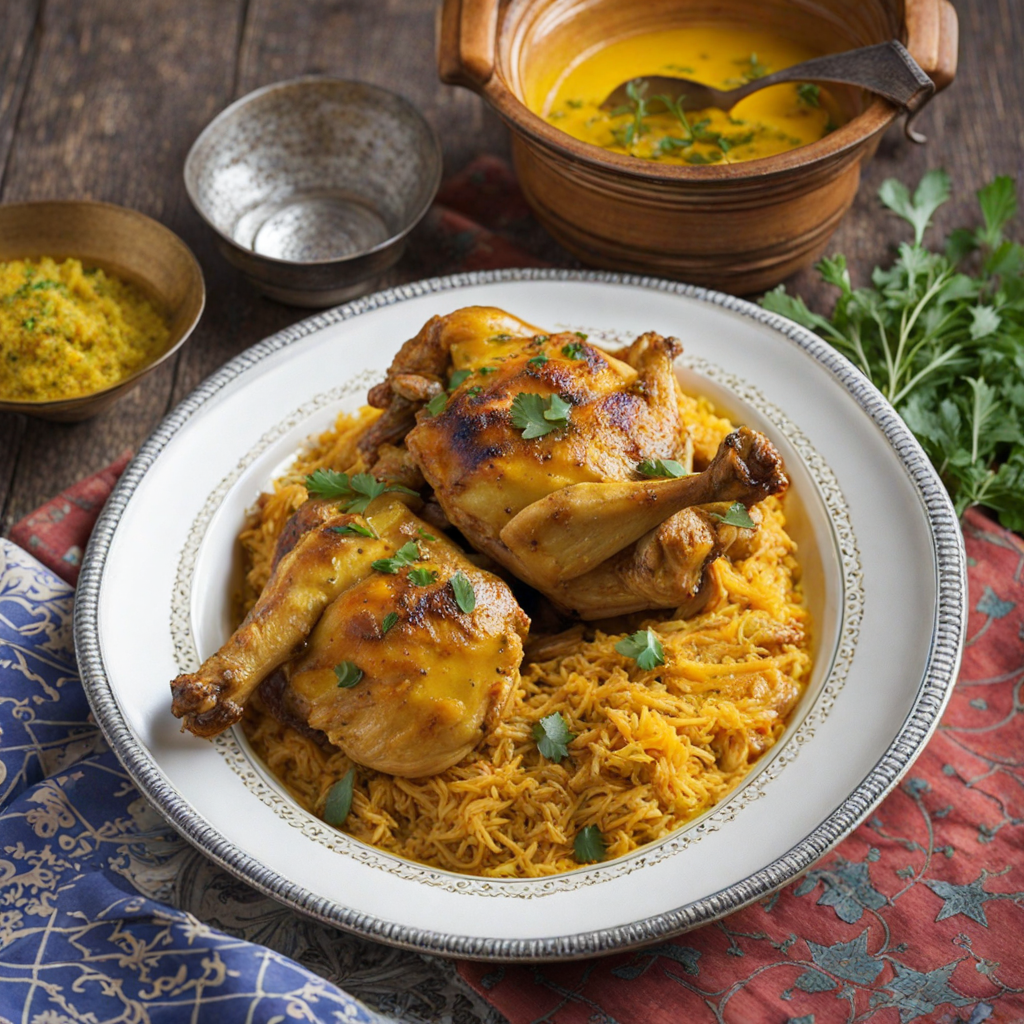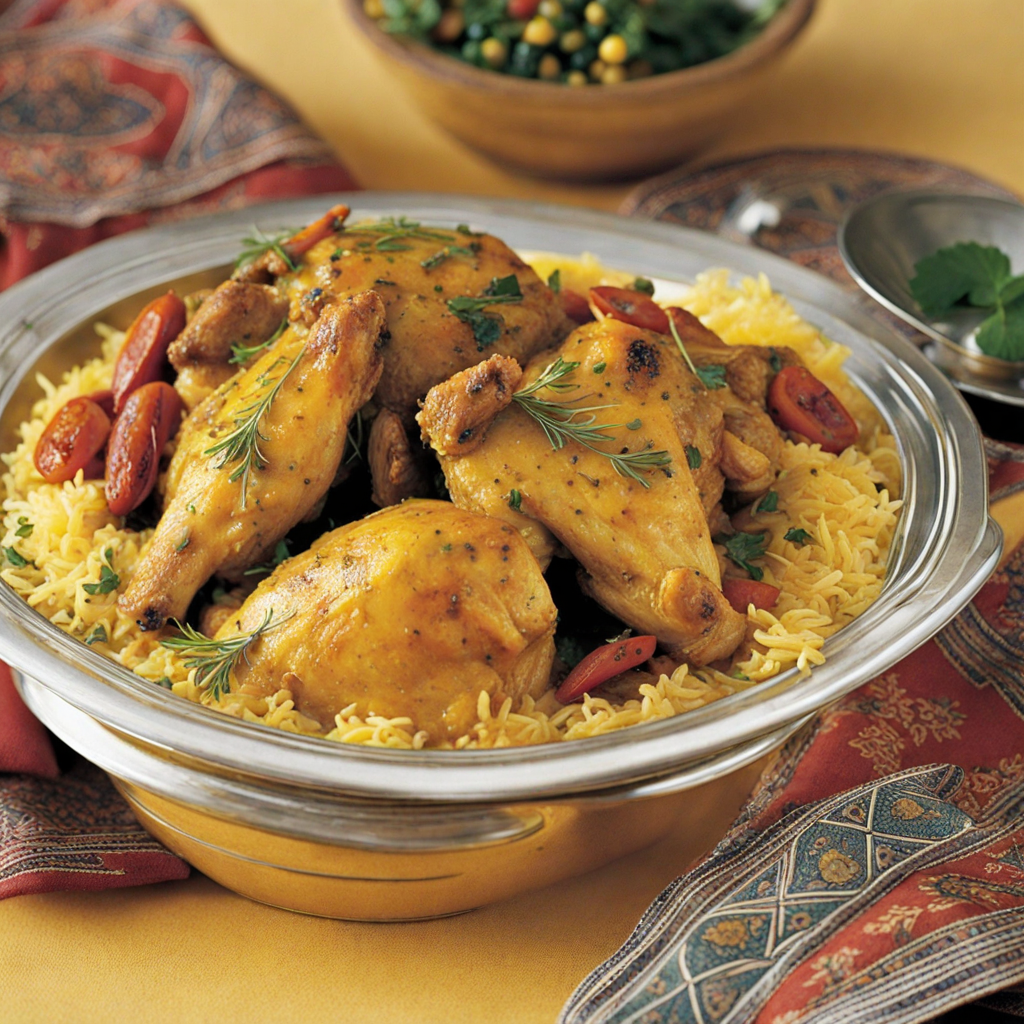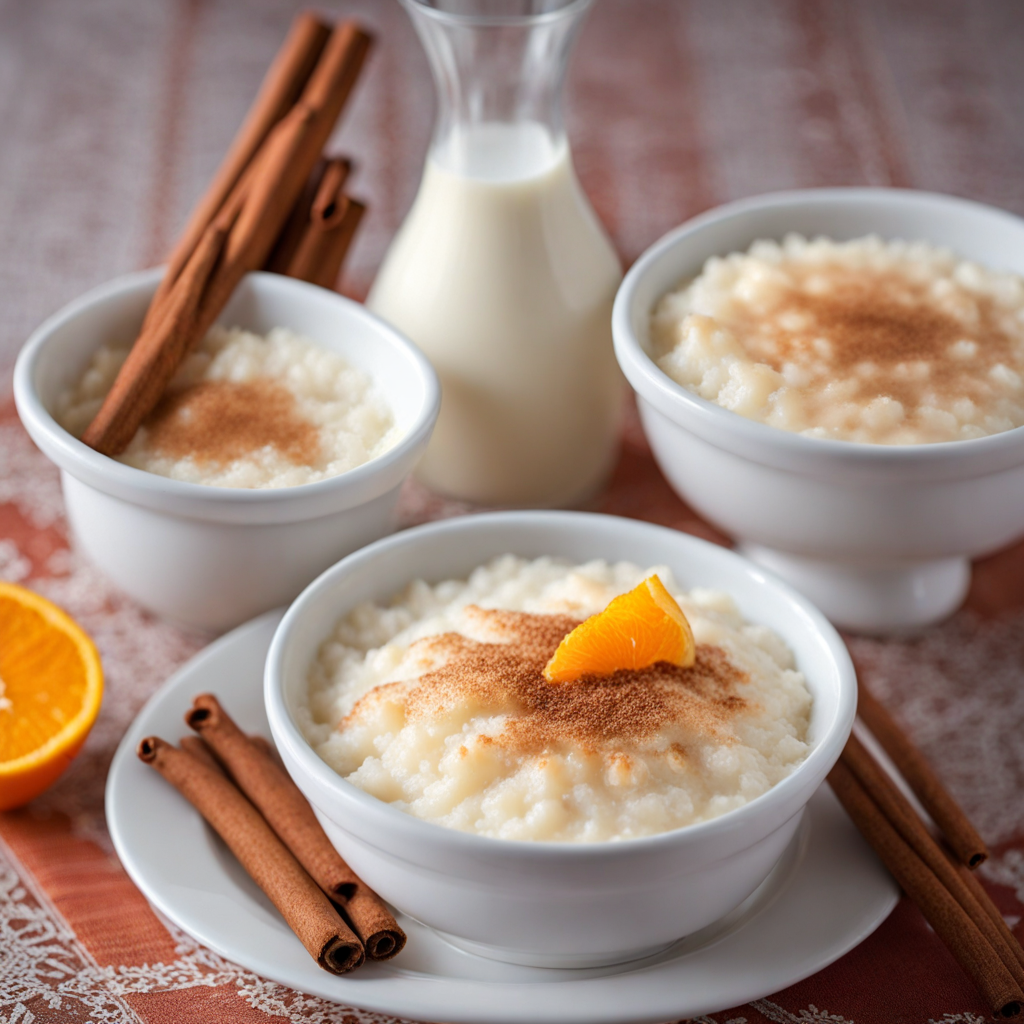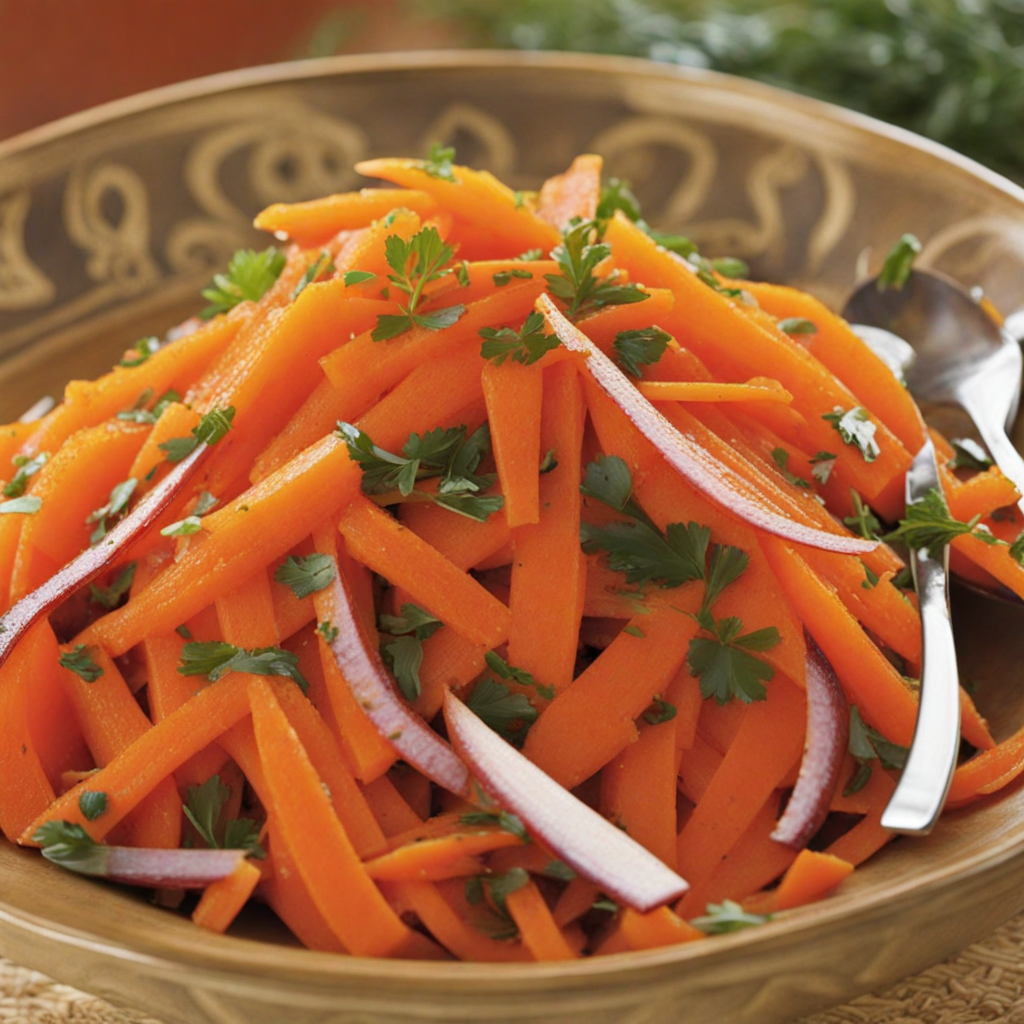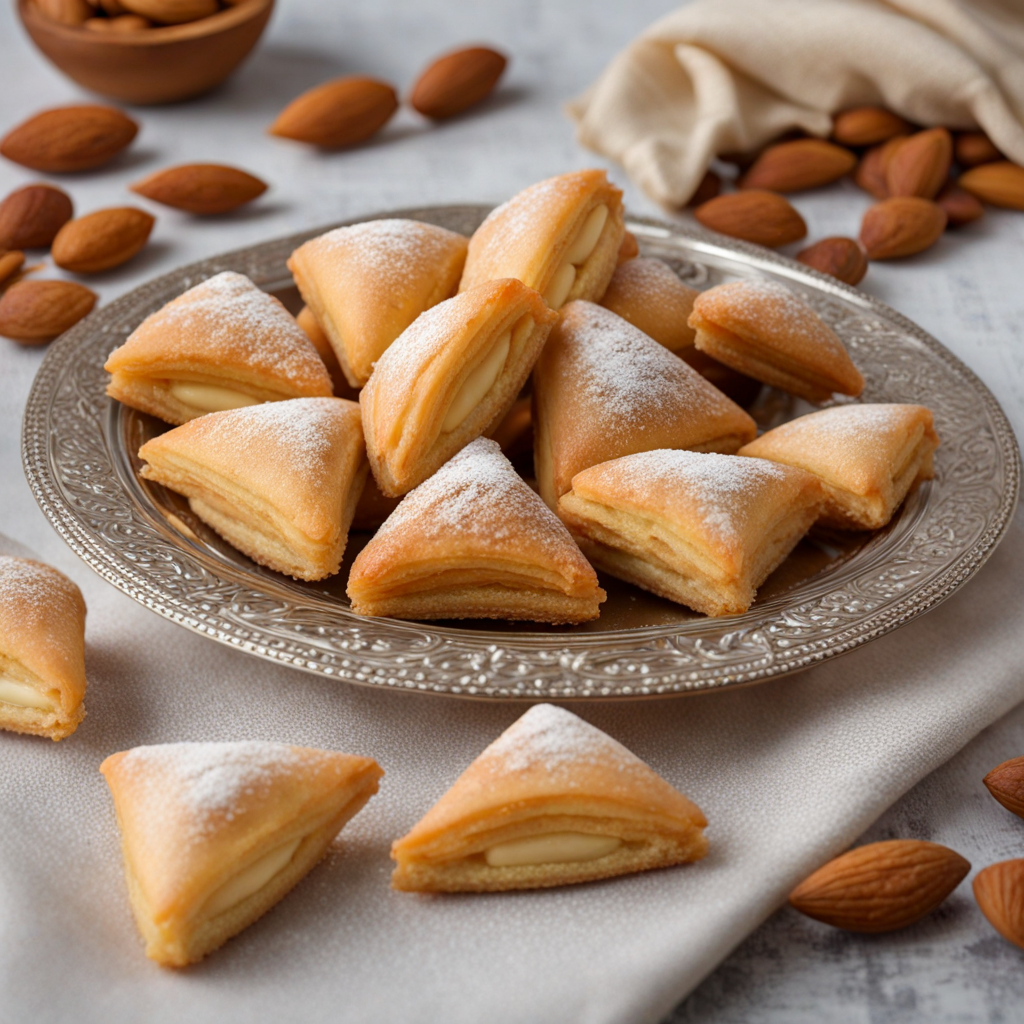Moroccan Saffron Chicken
Moroccan Saffron Chicken is a vibrant and aromatic dish that embodies the rich culinary traditions of Morocco. The chicken is typically marinated in a blend of spices, including cumin, coriander, and paprika, which infuse the meat with deep flavors. The star of the dish, however, is the precious saffron, known for its distinctive golden hue and delicate floral notes. This spice not only enhances the visual appeal of the dish but also adds a luxurious taste that elevates the overall experience. Cooked slowly with onions, garlic, and a medley of vegetables such as carrots and bell peppers, the chicken becomes tender and succulent, allowing the spices to meld beautifully together. The preparation of Moroccan Saffron Chicken often involves the use of a traditional tagine, a clay pot that helps to lock in moisture and flavor. As the chicken simmers, the saffron releases its vibrant color, staining the sauce a beautiful golden yellow. This dish is typically served over a bed of fluffy couscous, which soaks up the savory sauce, making each bite an explosion of flavor. The combination of spices, saffron, and the sweetness of caramelized onions creates a harmonious balance that is both comforting and exotic. To finish off the dish, it is often garnished with fresh herbs like cilantro or parsley, adding a burst of freshness that complements the rich flavors. A sprinkle of toasted almonds or olives may also be added for texture and an additional layer of taste. Moroccan Saffron Chicken is not just a meal; it’s a culinary journey that invites you to savor the essence of Moroccan cuisine, making it a delightful choice for anyone looking to explore new and exciting flavors.
How It Became This Dish
The History of دجاج بالزعفران المغربي (Moroccan Saffron Chicken) #### Origins and Ingredients دجاج بالزعفران المغربي, or Moroccan Saffron Chicken, is a dish that embodies the rich culinary tapestry of Morocco, a country located at the crossroads of Africa, Europe, and the Middle East. The origins of this dish can be traced back to the ancient Berber tribes, who were among the earliest inhabitants of Morocco. These indigenous people laid the foundation for the country’s culinary traditions, which later embraced various influences from Arab, Andalusian, and Mediterranean cultures. At its core, this dish features chicken as the centerpiece, often complemented by the aromatic and luxurious spice known as saffron. Saffron itself has a storied history, believed to have originated in ancient Persia and made its way to Morocco around the 7th century. The spice is derived from the flower of Crocus sativus, and its vibrant golden hue and distinct flavor have made it a prized ingredient across many cuisines. In Moroccan cooking, saffron is revered not just for its taste but also for its ability to elevate a dish’s visual appeal. The preparation of دجاج بالزعفران typically involves marinating the chicken in a blend of spices, including cumin, coriander, and paprika, alongside saffron. This marination process, often infused with garlic and preserved lemons, reflects the Moroccan penchant for robust flavors and aromatic profiles. #### Cultural Significance Moroccan cuisine is deeply intertwined with the country's culture, traditions, and social practices. Food in Morocco is more than sustenance; it is a means of celebration, community, and hospitality. دجاج بالزعفران, like many Moroccan dishes, is often served during special occasions such as weddings, religious festivals, and family gatherings. The act of preparing and sharing this dish fosters a sense of unity among family and friends, embodying the Moroccan value of hospitality. The use of saffron in particular carries cultural significance. It is often associated with wealth and prosperity, making it a fitting ingredient for celebratory dishes. The labor-intensive process of harvesting saffron—requiring thousands of flowers to produce just a small amount of the spice—has made it a symbol of luxury. In Moroccan households, serving a dish like دجاج بالزعفران can signify respect for guests and a desire to create memorable dining experiences. #### Cooking Techniques and Regional Variations The preparation of دجاج بالزعفران showcases traditional Moroccan cooking techniques, particularly the use of a tagine, a clay cooking vessel with a conical lid. This method allows for slow cooking, which helps meld the flavors of the spices and tenderize the chicken. The tagine is an essential part of Moroccan cuisine, and its use is emblematic of the country’s culinary heritage. While the basic concept of Moroccan Saffron Chicken remains consistent, regional variations have emerged over time. In coastal areas, where seafood is abundant, some variations may incorporate fish or shellfish. In the mountainous regions, the dish may be enhanced with locally sourced vegetables and nuts, reflecting the agricultural diversity of Morocco. Additionally, the incorporation of saffron is sometimes complemented by other ingredients such as apricots, almonds, or olives, which provide contrasting flavors and textures. These variations illustrate how Moroccan cooks have adapted traditional recipes to reflect local ingredients and personal preferences, ensuring the dish remains relevant and cherished across generations. #### Historical Context The history of دجاج بالزعفران cannot be divorced from the broader historical context of Morocco. The country has been shaped by a myriad of influences, from the Phoenicians and Romans to the Arab conquests and the subsequent establishment of the Almoravid and Almohad dynasties. Each of these periods introduced new ingredients, techniques, and flavors to the Moroccan culinary landscape. The arrival of the Arabs in the 7th century brought with it a wealth of spices and cooking methods that transformed Moroccan cuisine. Saffron, in particular, became a staple in the kitchens of the Moroccan elite, often reserved for special occasions. The establishment of trade routes across the Sahara and Mediterranean further facilitated the exchange of spices, enabling Moroccan cooks to experiment with a variety of flavors. During the Moroccan Renaissance in the 16th century, as the country experienced a cultural flourishing, culinary practices became more sophisticated. The convergence of different cultures led to a rich exchange of ingredients, which significantly influenced the preparation of dishes like دجاج بالزعفران. The royal courts became known for their opulent feasts, where saffron-infused dishes were a highlight, showcasing the culinary prowess of Moroccan chefs. #### Modern Adaptations In contemporary Morocco, دجاج بالزعفران continues to hold a cherished place in the national cuisine. While traditional recipes remain popular, modern adaptations have emerged, reflecting changing tastes and lifestyles. With the rise of globalization and the increasing availability of ingredients, home cooks and chefs alike have started to experiment with fusion versions of Moroccan Saffron Chicken, incorporating elements from other culinary traditions. Moreover, the popularity of Moroccan cuisine around the world has led to a renewed interest in traditional dishes. In restaurants, both in Morocco and abroad, دجاج بالزعفران is often presented with a modern twist, elevating its status as a gourmet dish while still honoring its roots. Cooking classes and culinary tours in Morocco frequently include sessions on preparing this dish, further solidifying its importance in the country’s gastronomic heritage. #### Conclusion دجاج بالزعفران المغربي is more than just a dish; it is a reflection of Morocco's rich history, cultural significance, and evolving culinary traditions. Its combination of flavors, techniques, and the luxurious touch of saffron encapsulates the essence of Moroccan hospitality and the importance of food in fostering connections among people. As Morocco continues to embrace its culinary heritage while welcoming global influences, this beloved dish remains a testament to the country's vibrant and enduring food culture. The journey of دجاج بالزعفران is a celebration of history, community, and the timeless art of cooking, ensuring its place on tables for generations to come.
You may like
Discover local flavors from Morocco


